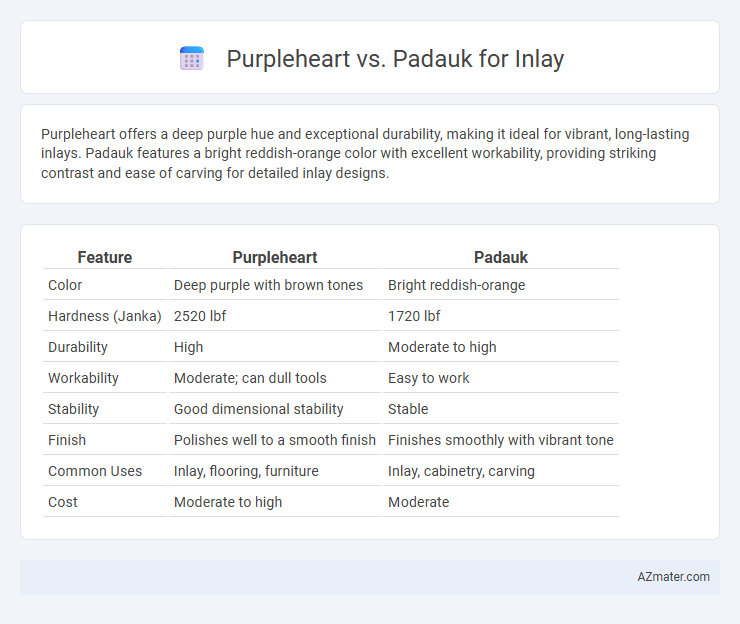Purpleheart offers a deep purple hue and exceptional durability, making it ideal for vibrant, long-lasting inlays. Padauk features a bright reddish-orange color with excellent workability, providing striking contrast and ease of carving for detailed inlay designs.
Table of Comparison
| Feature | Purpleheart | Padauk |
|---|---|---|
| Color | Deep purple with brown tones | Bright reddish-orange |
| Hardness (Janka) | 2520 lbf | 1720 lbf |
| Durability | High | Moderate to high |
| Workability | Moderate; can dull tools | Easy to work |
| Stability | Good dimensional stability | Stable |
| Finish | Polishes well to a smooth finish | Finishes smoothly with vibrant tone |
| Common Uses | Inlay, flooring, furniture | Inlay, cabinetry, carving |
| Cost | Moderate to high | Moderate |
Introduction: Purpleheart vs Padauk for Inlay Projects
Purpleheart and Padauk are popular hardwood choices for inlay projects due to their vibrant colors and durability. Purpleheart offers a rich, deep purple hue that darkens over time, providing a striking contrast in detailed designs. Padauk features a bright reddish-orange color that stabilizes to a warm, deep red, enhancing intricate patterns and adding warmth to woodworking inlays.
Wood Origin and Botanical Background
Purpleheart wood originates from the Peltogyne genus found in Central and South American rainforests, prized for its rich purple hue and dense, hard structure. Padauk comes from the Pterocarpus genus native to tropical Africa and Southeast Asia, known for its vibrant orange-red color and excellent durability. Both woods belong to the Fabaceae family, offering distinct botanical traits that influence their workability and visual appeal in inlay projects.
Distinctive Color and Grain Characteristics
Purpleheart offers a rich, deep purple hue that darkens with age, creating a striking contrast ideal for inlay projects, while Padauk showcases vibrant reddish-orange tones that darken to a warm brown over time. The grain of Purpleheart is typically straight to interlocked, providing a smooth, fine texture that enhances detailed inlays, whereas Padauk features a coarse, sometimes irregular grain pattern, adding rustic charm and pronounced character in designs. Both woods deliver unique visual appeal through their distinctive colors and grain traits, making them preferred choices for skilled craftsmen seeking bold, eye-catching inlays.
Hardness and Durability Comparison
Purpleheart wood rates around 2,960 on the Janka hardness scale, making it exceptionally resistant to dents and scratches, ideal for intricate inlay work requiring long-lasting durability. Padauk scores similarly high, approximately 2,200 to 2,580 on the Janka scale, offering impressive strength and resistance to wear, though generally slightly less dense than Purpleheart. Both hardwoods exhibit excellent durability and stability, but Purpleheart tends to outperform Padauk in hardness, making it the preferred choice for high-impact or heavily used inlay surfaces.
Workability and Machining Ease
Purpleheart offers moderate workability with a medium density that allows for precise inlay cuts using sharp tools and steady hands, minimizing the risk of splintering during intricate designs. Padauk boasts excellent machining ease due to its coarse grain and consistent texture, enabling smoother sanding and cleaner cuts, which is ideal for detailed inlay work. Both hardwoods respond well to careful handling, but Padauk's natural oils can slightly affect adhesion and finish application compared to Purpleheart's more stable surface.
Finishing Qualities and Longevity
Purpleheart offers a vibrant, deep purple hue that darkens to a rich brown over time with exposure to light and air, providing a striking contrast in inlay work but requiring UV protection to maintain its initial color. Padauk features a brilliant reddish-orange tone that ages to a warm, deeper red-brown and is known for its excellent natural durability and resistance to decay, making it ideal for long-lasting inlays. Both woods finish smoothly with oils and lacquers, yet Purpleheart demands careful sanding to avoid surface scratches, while Padauk's oily grain resists finishes slightly, necessitating additional surface preparation for optimal adhesion.
Stability and Movement in Inlay Applications
Purpleheart offers excellent stability and minimal movement in inlay applications due to its dense, fine-grained structure, making it less prone to warping or shrinking over time. Padauk, while vibrant and visually striking, exhibits higher natural movement because of its open grain and higher moisture responsiveness, which can lead to slight expansion or contraction in varying humidity conditions. Choosing Purpleheart ensures long-lasting, dimensionally stable inlays, whereas Padauk requires careful acclimation and sealed finishes to mitigate instability.
Price and Availability Factors
Purpleheart offers a rich, deep purple hue and is moderately priced, making it a popular choice for high-end inlays, while Padauk provides a vibrant reddish-orange color at a slightly lower cost. Purpleheart's availability can be limited due to sustainable sourcing practices, impacting price stability, whereas Padauk is more readily available, contributing to more consistent pricing. Both woods are durable and dense, but buyers often weigh Purpleheart's exclusivity against Padauk's affordability and easier accessibility for custom inlay projects.
Suitability for Decorative Inlays
Purpleheart offers a rich, deep purple hue that enhances intricate decorative inlays with its dense, fine grain and excellent workability, making it ideal for precision detailing. Padauk features vibrant orange-red tones that darken over time, providing striking visual contrast in inlays while maintaining durability and resistance to wear. Both woods' natural oils improve finish adhesion, but Purpleheart's stable nature and resistance to splitting give it a slight edge for delicate, high-precision decorative inlays.
Final Recommendations: Choosing the Best Wood
Purpleheart offers a rich, deep purple hue and exceptional durability, making it ideal for intricate inlays that require longevity and vibrant color contrast. Padauk provides a striking reddish-orange tone with good workability, perfect for bold, eye-catching designs where ease of carving and finishing are prioritized. Selecting between Purpleheart and Padauk depends on whether color vibrancy and hardness or carving ease and warm tones better suit the desired inlay aesthetic and project durability.

Infographic: Purpleheart vs Padauk for Inlay
 azmater.com
azmater.com